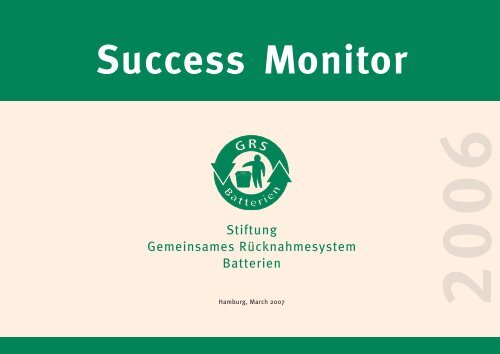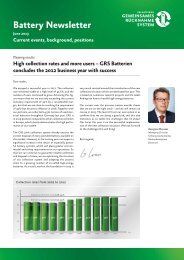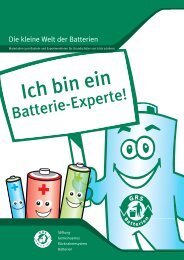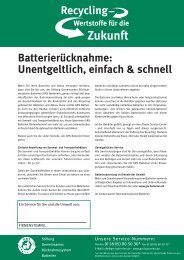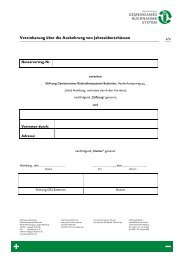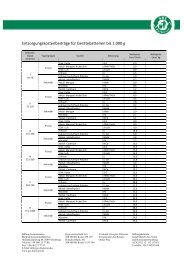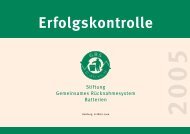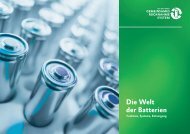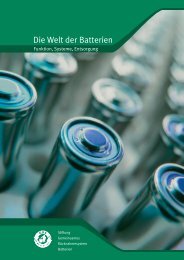2006 - GRS-Batterien
2006 - GRS-Batterien
2006 - GRS-Batterien
You also want an ePaper? Increase the reach of your titles
YUMPU automatically turns print PDFs into web optimized ePapers that Google loves.
Success Monitor<br />
Stiftung<br />
Gemeinsames Rücknahmesystem<br />
<strong>Batterien</strong><br />
Hamburg, March 2007 <strong>2006</strong>
2<br />
Table of contents<br />
1.<br />
2.<br />
3.<br />
4.<br />
5.<br />
Success Monitor in accordance with § 10(1) BattV<br />
(German Battery Decree)<br />
Table of contents 2<br />
Foreword 3<br />
Volume of batteries put into circulation / § 10(1)1. BattV 4<br />
Public relations 7<br />
Quality and environmental policy 8<br />
Volume of batteries collected,<br />
according to federal state / § 10(1)2. BattV 9<br />
Volume of batteries collected,<br />
according to origin / § 10(1)2. BattV 10<br />
6.<br />
7.<br />
8.<br />
9.<br />
10.<br />
11.<br />
Sorting of spent portable batteries 11<br />
Battery systems after sorting 12<br />
Recycling and disposal results /<br />
§ 10(1)3. BattV 13<br />
Summary of operative flow 16<br />
Prices paid for sorting,<br />
recycling and disposal / § 10(1)4. BattV 17<br />
Sources, abbreviations and definitions 18<br />
Imprint 19
1. Foreword<br />
<strong>GRS</strong> <strong>Batterien</strong> enjoyed extraordinary<br />
success in <strong>2006</strong>. Although there was no<br />
noticeable increase in the total weight<br />
of batteries and accumulators sold by<br />
manufacturers and importers, the quantity<br />
of batteries we collected nevertheless<br />
rose by 7 per cent year on year, to more<br />
than 13,000 tonnes. The targeted<br />
communication we have engaged in with<br />
our partners for many years is now<br />
beginning to show signs of paying off.<br />
The task we are now faced with is to<br />
maintain and improve this communication.<br />
We were also able to increase the<br />
proportion of returned batteries that are<br />
recycled to 88 per cent. And in spite of<br />
this increase in recycling, we were able<br />
to reduce specific costs in comparison<br />
to last year. This is partly due to the high<br />
price of metals in <strong>2006</strong>.<br />
It is important for us to be able to offer<br />
our customers excellent value for money.<br />
To do this, we are particularly interested<br />
in optimising costs while improving<br />
quality. Although the quantity of batteries<br />
collected has risen from approximately<br />
9,000 tonnes in 2000 to more than<br />
13,000 tonnes in <strong>2006</strong> and the proportion<br />
of batteries that are recycled has<br />
increased in that time from 33 % to 88 %,<br />
we have been able to keep disposal<br />
costs down at the same level as in 2000<br />
and have reimbursed our users with any<br />
surplus disposal fees.<br />
We endeavour to offer our customers<br />
outstanding services coupled with<br />
reasonable prices – something which we<br />
have achieved in the past and which we<br />
will continue to achieve in the future.<br />
We are therefore also grateful to our<br />
service providers and business partners<br />
for their dedicated engagement.<br />
We now intend to focus more on the<br />
EU’s environmental obligations,<br />
following the introduction of the new EU<br />
Battery Directive on 26 September <strong>2006</strong>.<br />
This directive must be enforced as<br />
national law by adapting Germany’s<br />
existing battery decree by October 2008<br />
at the latest. The new EU Battery<br />
Directive for the first time stipulates<br />
battery collection and recycling targets.<br />
<strong>GRS</strong> <strong>Batterien</strong> has already made<br />
provisions for this. The directive also<br />
lists fixed battery collection and<br />
recycling quotas for the first time. The<br />
minimum collection target has been<br />
pegged at 25 % for 2012 – <strong>GRS</strong> <strong>Batterien</strong><br />
has already surpassed this with<br />
approximately 38 %. <strong>GRS</strong> <strong>Batterien</strong> is also<br />
on course to meet the stipulated<br />
requirement that all identifiable batteries<br />
be recycled by 2009, as indicated by its<br />
recycling level of nearly 90 % in <strong>2006</strong>.<br />
In spite of these successes, there is no<br />
reason for us to rest on our laurels, as<br />
the battery collection quota stipulated<br />
by the EU for 2016 is 45 %, and this can<br />
only be achieved when all parties –<br />
from retailers to the municipalities and<br />
industry – continue to actively support<br />
the idea of battery collection.<br />
<strong>GRS</strong> <strong>Batterien</strong> has developed battery<br />
collection measures designed to help<br />
retailers, municipalities, and industrial<br />
users achieve the targets stipulated by<br />
the EU directive. Attention-grabbing<br />
promotions and intensive PR and media<br />
work motivate consumers to deposit<br />
batteries and accumulators at collection<br />
points.<br />
All future <strong>GRS</strong> <strong>Batterien</strong> communication<br />
activities will focus more heavily on the<br />
aspect of battery recycling: batteries<br />
contain raw materials that can be<br />
recovered and reused. And this is the key<br />
message that we want to communicate<br />
to consumers in order to encourage<br />
them to deposit their spent batteries for<br />
recycling. Some of <strong>GRS</strong> <strong>Batterien</strong>’s<br />
comprehensive PR work in 2007 will<br />
include highlights such as the BATT-<br />
Dr Jürgen Fricke<br />
Recycle Tour 2007 through 120 German<br />
towns and cities, recycling weeks hosted<br />
by trade partners, and the continuation<br />
of the ÖRE-Premium model (model<br />
for premium municipalities), which was<br />
launched successfully last year.<br />
Dr Jürgen Fricke,<br />
Chairman of the Board of <strong>GRS</strong> <strong>Batterien</strong><br />
Hamburg, March 2007<br />
3
4<br />
2. Volume of batteries put into circulation/§ 10(1)1. BattV<br />
As at 1 January <strong>2006</strong>, <strong>GRS</strong> <strong>Batterien</strong> had<br />
contractual relationships with 736 users.<br />
In the year under review, a further<br />
72 users took advantage of its services,<br />
thus increasing the number of manufacturers<br />
and importers that are contractual<br />
partners of <strong>GRS</strong> <strong>Batterien</strong> to 808 by the<br />
end of the year.<br />
A manufacturer is defined as anyone<br />
who manufactures batteries in Germany or<br />
has batteries manufactured, regardless<br />
of whether they are sold under a trademark<br />
or which trademark they bear. In<br />
the case of batteries without trademarks,<br />
whoever puts them into circulation for<br />
the first time in Germany is considered<br />
to be the manufacturer.<br />
This also applies to mail-order business.<br />
An importer is is defined as anyone who<br />
imports batteries into the Federal Republic<br />
of Germany and puts them into circulation<br />
for the first time there, regardless of the<br />
level of retail. (including mail-order<br />
business). This also applies to batteries<br />
built into appliances.<br />
The number of batteries sold by users<br />
in <strong>2006</strong> was at the same level as in the<br />
previous year. In comparison to 2005,<br />
the proportion of rechargeable (secondary)<br />
batteries rose again by one percentage<br />
point. Just under 22 % of all batteries sold<br />
in Germany in <strong>2006</strong> were rechargeable.<br />
Number of <strong>GRS</strong> <strong>Batterien</strong> users Development in battery sales according to battery types, 1999 – <strong>2006</strong><br />
Primary batteries Secondary batteries<br />
Source: KPMG; Deutsche Treuhandgesellschaft AG, Bielefeld
2. Volume of batteries put into circulation/§ 10(1)1. BattV<br />
Users of <strong>GRS</strong> <strong>Batterien</strong> put just short of<br />
1.5 billion batteries and accumulators into<br />
circulation in <strong>2006</strong>, which is 4 % more<br />
than in 2005. The total volume of batteries<br />
put into circulation amounted to<br />
34,736 tonnes, which is only slightly higher<br />
Primary batteries<br />
Secondary batteries<br />
than the previous year’s figure. There has<br />
been a drop in the weight per battery unit<br />
down the years, from 24.3 grams/unit in<br />
2005 to 23.4 grams/unit in the year under<br />
review. This is a reflection of the market<br />
trend towards smaller and smaller batteries.<br />
The majority of primary batteries continue<br />
to be alkaline-manganese (+3.2 % year on<br />
year), while sales of zinc-carbon batteries<br />
slumped again, by –23 % year on year. In<br />
<strong>2006</strong>, the proportion of primary zinc-carbon<br />
batteries was just 10 %. The sharpest rise<br />
among secondary batteries was achieved<br />
by lithium-ion accumulators. And while<br />
the volume of nickel-cadmium batteries<br />
rose by just under 3 %, the units of these<br />
batteries actually declined by 8 % year<br />
on year.<br />
Weight Quantity<br />
2005 <strong>2006</strong> Difference 2005 <strong>2006</strong> Difference<br />
kg % kg % kg % per 1,000 % per 1,000 % per 1,000 %<br />
Round cells** ZnC 4,717,446 13.6 3,616,472 10.4 –1,100,974 –23.3 194,505 13.6 151,551 10.2 –42,954 –22.1<br />
AlMn 22,162,384 64.0 22,874,233 65.9 711,849 3.2 889,728 62.4 941,372 63.5 51,644 5.8<br />
Zn-air 53,464 0.2 48,785 0.1 –4,679 –8.8 338 ‹0.1 359 ‹0.1 21 6.2<br />
Li, primary 218,979 0.6 219,666 0.6 687 0.3 14,639 1.0 14,646 1.0 7 ‹0.1<br />
Button cells AgO* 40,068 0.1 36,119 0.1 –3,949 –9.9 24,920 1.7 24,946 1.6 26 0.1<br />
AlMn* 163,300 0.5 148,777 0.4 –14,523 –8.9 57,889 4.1 84,019 5.7 26,130 45.1<br />
Zn-air 59,553 0.2 58,496 0.2 –1,057 –1.8 66,980 4.7 64,021 4.3 –2,959 –4.4<br />
Li, primary 169,080 0.5 244,112 0.7 75,032 44.4 52,661 3.7 60,456 4.1 7,795 14.8<br />
Sum 27,584,274 79.7 27,246,660 78.4 –337,614 –1.2 1,301,660 91.2 1,341,370 90.4 39,710 3.1<br />
Round cells** AlMn 40,642 0.1 75,662 0.2 35,020 86.2 1,564 0.1 2,164 0.1 600 38.4<br />
Li-ion 2,212,384 6.3 2,480,805 7.1 268,421 12.1 29,516 2.1 34,824 2.4 5,308 18.0<br />
NiMH 1,921,010 5.6 1,952,781 5.6 31,771 1.7 69,057 4.8 79,235 5.3 10,178 14.7<br />
Pb 1,015,389 2.9 1,069,969 3.1 54,580 5.4 823 ‹0.1 1,010 0.1 187 22.7<br />
NiCd 1,830,150 5.3 1,881,681 5.4 51,531 2.8 18,564 1.3 17,001 1.2 –1,563 –8.4<br />
Button cells Li-ion 7,747 ‹0.1 15,283 ‹0.1 7,536 97.3 2,848 0.2 5,115 0.3 2,267 79.6<br />
NiMH 12,789 ‹0.1 13,007 ‹0.1 218 1.7 2,404 0.2 2,677 0.2 273 11.4<br />
NiCd 295 ‹0.1 176 ‹0.1 –119 –40.3 87 ‹0.1 90 ‹0.1 3 3.4<br />
Sum 7,040,406 20.3 7,489,364 21.6 448,958 6.4 124,863 8.8 142,116 9.6 17,253 13.8<br />
Total 34,624,680 100.0 34,736,024 100.0 111,344 0.3 1,426,523 100.0 1,483,468 100.0 56,963 4.0<br />
Volume (kg) / quantity of batteries put into circulation by users<br />
Source: KPMG, Deutsche Treuhandgesellschaft AG, Bielefeld; the data is based on the quantities registered with <strong>GRS</strong> <strong>Batterien</strong> until this report was written<br />
* Includes round cells made up of button cells<br />
** Includes battery packs<br />
5
6<br />
AlMn 65.9 %<br />
2. Volume of batteries in circulation/§ 10(1)1. BattV<br />
Total<br />
34,736 tonnes of batteries and accumulators were<br />
brought into circulation on the German market by<br />
users of <strong>GRS</strong> <strong>Batterien</strong> in <strong>2006</strong>. 78.4 % of these were<br />
primary batteries (previous year 79.7 %) and 21.6 %<br />
were secondary batteries (previous year 20.3 %).<br />
Percentage of all batteries<br />
put into circulation, volume<br />
AlMn. secondary 0,2 %<br />
* All types of button cells<br />
Li-ion 7.1 %<br />
Pb 3.1 %<br />
ZnC 10.4 %<br />
Li, primary 0.6 %<br />
Zn-air 0.1 %<br />
Button cells* 1.6 %<br />
NiCd 5.4 %<br />
NiMH 5.6 %<br />
Percentage of batteries put into circulation by <strong>GRS</strong> <strong>Batterien</strong> users<br />
Source: KPMG, Deutsche Treuhandgesellschaft AG, Bielefeld<br />
Primary<br />
A total of 27,247 tonnes of primary batteries were put<br />
into circulation, which was 338 tonnes fewer than<br />
in the previous year. The main type of primary batteries<br />
continues to be alkaline-manganese batteries at<br />
84 %. In <strong>2006</strong>, their tonnage went up year on year<br />
by 712 tonnes to 22,874 tonnes. In contrast, the<br />
tonnage of zinc-carbon batteries slumped by more<br />
than 1,100 tonnes in <strong>2006</strong>, from 4,717 tonnes in the<br />
previous year to 3,616 tonnes.<br />
Percentage of primary batteries<br />
put into circulation, volume<br />
AlMn 83.9 %<br />
Zn-air 0.2 %<br />
Button cells* 1.8 %<br />
Li, primary 0.8 %<br />
ZnC 13.3 %<br />
Secondary<br />
While the volume of primary batteries put into<br />
circulation fell slightly year on year, the proportion<br />
of secondary batteries went up by 449 tonnes to<br />
7,489 tonnes. This can be attributed primarily to<br />
Li-ion batteries, the volume of which increased by<br />
no less than 268 tonnes brought into circulation<br />
year on year Li-ion batteries also account for 33 %<br />
of all rechargeable batteries.<br />
Percentage of secondary batteries<br />
put into circulation, volume<br />
NiCd 25.1 %<br />
NiMH 26.1 %<br />
AlMn 1.0 %<br />
Button cells* 0.4 %<br />
Pb 14.3 %<br />
Li-ion 33.1 %
3. Public relations<br />
Motivating everyone to play their part<br />
Once again in <strong>2006</strong>, <strong>GRS</strong> <strong>Batterien</strong><br />
managed to increasingly motivate private<br />
and industrial consumers, the industry,<br />
retail and municipalities to return spent<br />
batteries and accumulators with the help<br />
of numerous high-profile campaigns.<br />
Its dovetailed and highly congruous PR<br />
activities to boost battery collection<br />
met with resounding public approval.<br />
The ÖRE-Premium-Programm<br />
In <strong>2006</strong>, <strong>GRS</strong> <strong>Batterien</strong> devised a scheme<br />
for municipalities to expand their battery<br />
collection activities, offering them attractive<br />
services to that end. For example,<br />
<strong>GRS</strong> <strong>Batterien</strong> supported its premium<br />
partners’ battery collection weeks and<br />
similar events by providing promotional<br />
modules such as a pushalong car<br />
race and a painting studio. Both of these<br />
interactive promotions served as an<br />
entertaining way to encourage people to<br />
collect and return their batteries. In<br />
addition to advertising on refuse lorries,<br />
<strong>GRS</strong> <strong>Batterien</strong> also assisted municipalities<br />
with radio bulletins and ads and reports<br />
in local papers. It also provided “Mini-<br />
BATT” boxes (small battery collection<br />
boxes for individual households), handing<br />
them out as consumer giveaways at local<br />
recycling collection points. The scheme<br />
proved to be hugely popular and has<br />
therefore been extended into 2007 with<br />
new creative ideas. <strong>GRS</strong> <strong>Batterien</strong> was<br />
particularly successful in capitalising on<br />
the World Cup being in Germany in<br />
<strong>2006</strong>, launching an Internet-based game<br />
which allowed the municipalities to<br />
predict the scores of World Cup matches.<br />
The group that scored the most in the<br />
game won a free battery collection day,<br />
while the two runner-up teams were<br />
awarded a sum of money to be donated<br />
to an environmental project.<br />
Forum on the EU Battery Directive<br />
In October <strong>2006</strong>, <strong>GRS</strong> <strong>Batterien</strong> hosted<br />
an information and discussion forum<br />
in Berlin which was attended by battery<br />
manufacturers, experts from the environmental<br />
and waste disposal sector, trade<br />
reps and representatives of government<br />
authorities. The delegates addressed<br />
highly topical issues such as the obligations<br />
of the new EU Battery Directive<br />
and the status quo of battery collection,<br />
sorting and recycling in Germany. The<br />
issues discussed were also prepared for<br />
use in the daily press and in specialist<br />
publications, in order to reach as wide<br />
an audience as possible.<br />
Media power across the board<br />
Due to extensive PR work, the topic of<br />
battery collection was in the public eye<br />
VIPs at the forum on the EU Battery Directive:<br />
Dipl.-Ing. Otmar Frey, <strong>GRS</strong> <strong>Batterien</strong>, chairman of the<br />
advisory council; Victoria Herrmann, presenter;<br />
Dr Jürgen Fricke, <strong>GRS</strong> <strong>Batterien</strong>, chairman of the board<br />
of management; Dr Thomas Rummler, BMU, permanent<br />
ministerial secretary.<br />
throughout the year, with a total of nearly<br />
290 million contacts through all the<br />
media channels. Nearly 140 million of<br />
these contacts alone were radio bulletins,<br />
followed by 76 million publications in<br />
daily papers, general-interest magazines<br />
and the specialist press. Most contacts<br />
were in the form of ads and copy in<br />
high-circulation TV guides and retailers’<br />
consumer magazines. Some 66 million<br />
contacts were generated on the Internet.<br />
There were also TV reports on programmes<br />
such as “ARD Ratgeber Technik”<br />
and “ZDF drehscheibe Deutschland”. In<br />
addition, the website www.grs-batterien.<br />
de provides consumers and experts alike<br />
with interesting information relating to<br />
batteries and battery collection, ranging<br />
from the latest legal stipulations to<br />
teaching materials for schools.<br />
Collecting batteries for the common good<br />
We also ran numerous high-profile<br />
environmental campaigns, such as a<br />
pit stop for schoolkids run by the<br />
Verbraucherzentrale NRW (consumer<br />
advice centre) and a photography<br />
competition run in conjunction with the<br />
HDE (Association of German Retailers).<br />
There was also a great media response<br />
to other environmental initiatives such<br />
as the Energy Day run by the town of<br />
Plauen, a battery collection drive in<br />
Halle an der Saale and a similar drive run<br />
in conjunction with the Bergisch Gladbach<br />
town council and the local waste disposal<br />
company. In addition to these battery<br />
collection drives, <strong>GRS</strong> <strong>Batterien</strong> was also<br />
involved in other social projects, such<br />
as supporting the Fördergemeinschaft<br />
Kinderkrebs-Zentrum Hamburg e.V.<br />
(funding association for the Hamburg<br />
childhood cancer centre). It is this kind<br />
of activity that is given a high public<br />
profile, with the general public backing<br />
battery collection and getting the<br />
message across that it is an active form<br />
of environmental protection.<br />
7
8<br />
4. Quality and environmental policy<br />
The basic aspect of<br />
our quality and environmental policy<br />
is customer satisfaction<br />
<strong>GRS</strong> <strong>Batterien</strong> assumes responsibility<br />
for collecting batteries on behalf of its<br />
users along with all other conditions<br />
stipulated by the Battery Decree, and<br />
endeavours to achieve the following<br />
within an acceptable cost remit:<br />
• Increasing the quantity of spent<br />
portable batteries that are collected<br />
• Sorting the batteries in order<br />
to improve their recyclability<br />
• Increasing the proportion of and<br />
quality of recycled materials<br />
<strong>GRS</strong> <strong>Batterien</strong> undertakes to comply with<br />
all regulations and implement sustainable<br />
and forward-looking development.<br />
<strong>GRS</strong> <strong>Batterien</strong> avoids untenable risks in<br />
all its planning, development and<br />
implementation work. The primary objective<br />
is to keep the customers satisfied.<br />
And to do this, <strong>GRS</strong> <strong>Batterien</strong> has<br />
introduced a combined quality and<br />
environmental management system<br />
which addresses the needs of all the<br />
parties involved.<br />
Ongoing improvement is an integral part<br />
of all <strong>GRS</strong> <strong>Batterien</strong> corporate processes.<br />
In all of this,<br />
As value-added partners,<br />
the service providers play a substantial<br />
role in providing good quality<br />
In accordance with the German Battery<br />
Decree, the service providers are selected<br />
every three years via a process that<br />
promotes competition. Here too, <strong>GRS</strong><br />
<strong>Batterien</strong> sets great store by quality and<br />
environmental protection. The selection<br />
process therefore includes a suitability<br />
test for all sorting, recycling and waste<br />
disposal plants before the call for bids.<br />
Companies are not accepted as bidders<br />
until they are deemed to be suitable<br />
and the environmental friendliness of their<br />
services has been established. Once this<br />
elimination stage has been completed,<br />
the plants are invited to tender their bids<br />
in a public tendering procedure, which<br />
is used as the basis for the final decision.<br />
This drawn-out selection process is a<br />
success, as borne out by the fact that<br />
the complaints quota for battery and<br />
accumulator collection constantly remains<br />
below 1 %.<br />
A good choice for manufacturers<br />
and importers<br />
Another major advantage of this selection<br />
process is that services can be sourced<br />
at low prices, which gives manufacturers<br />
and importers who use <strong>GRS</strong> <strong>Batterien</strong><br />
services excellent value for money. We<br />
also have a team of experts at the ready<br />
to answer all of our customers’ questions<br />
relating to battery disposal.
5. Volume of batteries collected, according to federal state / § 10(1)2. BattV<br />
Federal state 2005 <strong>2006</strong> Difference<br />
t t t %<br />
Baden-Württemberg 1,683 1.800 117 7<br />
Bayern 2,143 2.353 210 10<br />
Berlin 416 421 5 1<br />
Brandenburg 297 313 16 5<br />
Bremen 115 114 –1 –1<br />
Hamburg 265 265 0 0<br />
Hessen 693 719 26 4<br />
Mecklenburg-Vorpommern 138 150 12 9<br />
Niedersachsen 1,579 1.522 –57 –4<br />
Nordrhein-Westfalen 2,554 2.942 388 15<br />
Rheinland-Pfalz 688 733 45 7<br />
Saarland 134 148 14 10<br />
Sachsen 488 507 19 4<br />
Sachsen-Anhalt 245 263 18 7<br />
Schleswig-Holstein 577 590 13 2<br />
Thüringen 248 298 50 20<br />
Total 12,263 13,138 875 7<br />
The quantity of spent portable batteries<br />
collected in <strong>2006</strong> increased by nearly<br />
900 tonnes to 13,138 tonnes, which is<br />
equivalent to a year-on-year increase<br />
of 7 %. The nationwide presence of <strong>GRS</strong><br />
<strong>Batterien</strong> in the retail and industry, good<br />
working relationships with municipalities,<br />
and extensive PR work contributed to an<br />
increase in the specific battery collection<br />
quantity (grams per head in the year<br />
under review to 159 g/head (previous<br />
year 149 g/head). There continue to be<br />
large differences between the quantities<br />
returned in the different federal states.<br />
This is partly because some retail chains<br />
and manufacturers collect batteries<br />
throughout the country and make them<br />
available to <strong>GRS</strong> <strong>Batterien</strong> in central<br />
warehouses.<br />
51 to 100 g / head.<br />
101 to 150 g / head.<br />
151 to 200 g / head.<br />
>200 g / head.<br />
Volume of<br />
batteries collected<br />
Ø 159 g / head.<br />
9
10<br />
5. Volume of batteries collected, according to origin / § 10(1)2. BattV<br />
As in previous years, the most popular<br />
channel for battery collection was in retail<br />
in <strong>2006</strong>. Just under half (49 %) of all spent<br />
batteries and accumulators collected by<br />
<strong>GRS</strong> <strong>Batterien</strong> were sourced from retail.<br />
The proportion of batteries coming from<br />
municipalities fell by a percentage point<br />
year on year, while the proportion coming<br />
from the trade industry rose by the same<br />
amount. There was next to no change<br />
year on year in the volume of batteries<br />
and accumulators sourced from waste<br />
electrical and electronic equipment being<br />
stripped down, suggesting that the EU<br />
Municipalities 25 %<br />
Municipalities 24 %<br />
Industry 25 %<br />
Industry 26 %<br />
directive on waste electrical and electronic<br />
equipment had had little effect. In the<br />
year under review, more collection points<br />
in the retail and industry were provided<br />
with collection containers.<br />
The origin of spent batteries and accumulators<br />
varies greatly from state to<br />
state. This is due to the very different<br />
waste disposal structures around the<br />
country. The proportion of municipalities<br />
in Hessen is just 5 %, because very<br />
few municipalities there make use of<br />
the <strong>GRS</strong> <strong>Batterien</strong> services.<br />
Armed forces 1 %<br />
Armed forces 1 %<br />
Retail 49 %<br />
Retail 49 %<br />
Municipalities Industry<br />
Retail Armed forces
6. Sorting of spent portable batteries<br />
The sorting process<br />
Portable batteries and accumulators are<br />
collected as a mixture, as consumers<br />
are not in a position to presort them. The<br />
batteries are then sorted into electrochemical<br />
systems after they have been<br />
collected. The <strong>GRS</strong> <strong>Batterien</strong> service<br />
providers use two different sorting<br />
methods:<br />
• X-ray method<br />
The batteries are sorted according to size<br />
and the round cells pass through an X-ray<br />
sensor. The type of battery is identified<br />
on the basis of the grey areas on the<br />
X-ray. This system is capable of sorting<br />
more than 20 batteries a second with<br />
accuracy of over 98 %.<br />
• Electromagnetic method<br />
This method identifies types of magnetic<br />
round cells with the help of an electromagnetic<br />
sensor. The sensor’s magnetic<br />
field changes according to the electrochemical<br />
battery type passing it, thus<br />
identifying up to six battery types a<br />
second. This system likewise has a sorting<br />
accuracy of 98 %.<br />
These sorting facilities have a total sorting<br />
capacity of more than 15,000 t/a.<br />
Mercury in batteries<br />
Year in, year out, <strong>GRS</strong> <strong>Batterien</strong> analyses<br />
the mercury content of the AlMn and<br />
ZnC batteries it collects. The results of this<br />
analysis indicate that the mercury<br />
content in batteries is steadily declining.<br />
This means it will be possible to recycle<br />
more and more of these type of batteries<br />
in the future.<br />
Recycling – the objective of sorting<br />
Sorting the collected batteries serves one<br />
purpose, that being inexpensive and<br />
environmentally friendly recycling. This<br />
means the sorting process must meet<br />
the specifications of the corresponding<br />
recycling plants. Once again in the year<br />
under review, <strong>GRS</strong> <strong>Batterien</strong> initiated<br />
two R&D projects with a view to aligning<br />
the battery sorting even more with the<br />
ultimate recycling processes.<br />
Sources: GMA (top), Uni-Cyc (bottom)<br />
11
12<br />
7. Sorted battery systems<br />
The majority of battery sorting was<br />
undertaken by the companies Uni-Cyc<br />
GmbH and GMA mbH & Co. KG. Sorting<br />
is a basic prerequisite for subsequent<br />
recycling. The total sum of batteries<br />
sorted in the year under review was<br />
12,426 tonnes. This includes some<br />
batteries that were collected in 2005,<br />
but that had been stored unsorted in<br />
intermediate storage or at the sorting<br />
plants. <strong>GRS</strong> <strong>Batterien</strong> requires NiCd<br />
and NiMH batteries to be sorted to an<br />
accuracy of at least 99 % for them to<br />
be recyclable, and expects an accuracy<br />
level of 98 % for all other battery types.<br />
As in the previous year, the majority of<br />
sorted batteries (79 %) were AlMn and ZnC<br />
batteries. Of these, the proportion of<br />
ZnC batteries in the waste stream had<br />
once again dropped year on year, to<br />
29.0 % (previous year 30.6 %). In comparison,<br />
sales of ZnC batteries accounted<br />
for just 10 % of all sales (average of<br />
previous three years 13.6 %). This is<br />
because batteries that can only be run<br />
2005 <strong>2006</strong> Difference<br />
t % t % t %<br />
ZnC 3,705 30.6 3,601 29.0 –104 –2.8<br />
AlMn 5,823 48.1 6,215 50.0 392 6.7<br />
Zn-air 179 1.5 199 1.6 20 11.2<br />
Li, primary 206 1.7 174 1.4 –32 –15.5<br />
Button cells* 61 0.5 62 0.5 1 1,6<br />
Summe 9,974 82.4 10,251 82.5 277 2.8<br />
Li-ion 61 0,5 50 0.4 –11 –18.0<br />
NiMH 73 0.6 75 0.6 2 2.7<br />
AIMn ** 0 0 0 0 0 0<br />
Pb 1,065 8.8 1,031 8.3 –34 –3.2<br />
NiCd 896 7.4 895 7.2 –1 –0.1<br />
Sum 2,095 17.3 2,051 16.5 –44 –2.1<br />
Sorting residuals 36 0.3 124 1.0 88 244.4<br />
Total*** 12,105 100 12,426 100 321 2.7<br />
Primary<br />
batteries<br />
Secondary<br />
batteries<br />
* Comprises all battery types ** In AlMn primary batteries<br />
*** Mixed batteries (unsortable) divided up on the basis of the proportions of sorted batteries<br />
flat once often do not find their way<br />
into the waste stream until years after<br />
having been sold.<br />
The ratio of primary batteries to secondary<br />
batteries remained unchanged from<br />
the previous year. Rechargeable NiMH and<br />
Li-ion batteries are long-life batteries so<br />
the rate of return for these remains low.<br />
An R&D trial was implemented in order<br />
to form a stronger link between sorting<br />
and recycling locations, and to fine-tune<br />
the sorting process to better meet the<br />
needs of the different recycling plants.<br />
Some recycling processes allow for zinccarbon<br />
and alkali-manganese batteries<br />
to be recycled together. <strong>GRS</strong> <strong>Batterien</strong><br />
will continue to endeavour to fine-tune<br />
battery sorting to the recycling processes<br />
and establish these sorting processes on<br />
the market.<br />
AlMn 50.0 % ZnC 29.0 %<br />
Sorting residuals 1.0 %<br />
Li-ion 0.4 %<br />
NiMH 0.6 %<br />
Zn-air 1.6 %<br />
Button cells* 0.5 %<br />
Li, primary 1.4 %<br />
Pb 8.3 %<br />
NiCd 7.2 %
8. Recycling and disposal results/§ 10(1)3. BattV<br />
8.1 Evaluation of the recycling and disposal proportions<br />
The proportion of batteries being recycled<br />
continued to rise in <strong>2006</strong>, to 88 % of all<br />
sorted batteries (previous year 82 %).<br />
The focus here is on recycling methods<br />
that result in high-quality products. One<br />
such method is the blast furnace at DK<br />
Recycling und Roheisen GmbH, which is<br />
used to recycle UV-coded AlMn batteries<br />
and extract raw materials such as pig<br />
iron, zinc concentrate and slag. There<br />
now follows a brief description of<br />
different recycling methods for specific<br />
battery types.<br />
Source: <strong>GRS</strong> <strong>Batterien</strong><br />
AlMn and ZnC batteries:<br />
There are other recycling methods in<br />
addition to the blast furnace. For example,<br />
the two companies Redux GmbH and<br />
GMA mbH & Co. KG grind down AlMn<br />
and ZnC batteries in a monitored process<br />
and separate the iron content from the<br />
zinc content. The iron is passed on to<br />
steelworks and the zinc-based fine fraction<br />
is turned into zinc oxide in rotary kilns.<br />
The electric arc furnace belonging to Valdi<br />
in Feurs (France) is used to turn batteries<br />
into materials such as ferromanganese<br />
and zinc oxide.<br />
Disposal Recycling<br />
Button cells containing mercury:<br />
The company NQR in Lübeck uses the<br />
ALD (atomic layer deposition) process,<br />
in which waste containing mercury<br />
undergoes vacuum thermal treatment.<br />
At temperatures ranging from 350° C<br />
to 650° C, the mercury evaporates, then<br />
condensates at a lower temperature,<br />
before being put back into economic<br />
use. The mercury-free steel is sold.<br />
NiCd batteries:<br />
Spent NiCd accumulators are recycled by<br />
Accurec in Mülheim and SNAM in France.<br />
The cadmium is usually distilled in a<br />
vacuum or in an inert atmosphere and<br />
the steel / nickel alloy that is left is passed<br />
on to the steelmaking industry. The<br />
resultant cadmium is generally used to<br />
make new NiCd batteries.<br />
NiMH batteries:<br />
The expertise of Redux in Dietzenbach<br />
lies in reclaiming nickel. As there is the<br />
risk of hydrogen being released when<br />
NiMH batteries are ground down, this is<br />
done in a monitored environment. Once<br />
the plastics have been separated, what<br />
is left is a high nickel containing product,<br />
and this serves as an important alloying<br />
component for the steelmaking industry.<br />
Lithium batteries:<br />
<strong>GRS</strong> <strong>Batterien</strong> commissions Accurec in<br />
Mülheim with the recycling of lithium<br />
primary batteries (LiMnO2) in a vacuum<br />
distillation process. This is primarily<br />
used to regain nickeliferous iron and<br />
ferromanganese. Lithium is used in the<br />
process as a reductant. Rechargeable<br />
lithium-type batteries (Li-ion and Lipolymer)<br />
are recycled by Falconbridge,<br />
which first and foremost recycles to<br />
regain cobalt, nickel and copper.<br />
13
14<br />
Final disposal<br />
1,550 t (12 %)<br />
Mixed batteries 81 %<br />
8. Recycling and disposal results/§ 10(1)3. BattV<br />
8.2 Quantitative recycling and disposal proportions<br />
Sorting residuals 7 %<br />
In the reporting period, 12,686 tonnes<br />
of batteries were either recycled or<br />
disposed of by the disposal plants. The<br />
proportion of recycled batteries rose<br />
once again, to 88 % (previous year 82 %).<br />
A total of 1,550 tonnes of batteries<br />
(12 %) were sent to hazardous waste<br />
disposal sites owned by IAG in Selmsdorf<br />
and HIM GmbH in Billigheim. The majority<br />
of batteries to be disposed of were<br />
unsortable batteries and non-UV-coded<br />
AlMn batteries.<br />
AlMn, uncoded 12 %<br />
Disposal<br />
12,686 t (100 %)<br />
The Battery Directive published in the<br />
EU’s Official Journal in September <strong>2006</strong><br />
must be enforced as national law by<br />
September 2008 and stipulates that all<br />
identifiable batteries must undergo material<br />
recycling by September 2009 (recycling<br />
proportion). It also stipulates that the<br />
following minimum recycling efficiency<br />
levels be achieved by September 2011:<br />
Recycling<br />
11,136 t (88 %)<br />
ZnC Hg-free 4 % AlMn, uncoded 35 %<br />
ZnC, uncoded 26 %<br />
AlMn Hg-free 13 %<br />
Mixed batteries 1 %<br />
NiMH 1 %<br />
Pb 8 %<br />
NiCd 8 %<br />
• 65 % of the average weight of lead<br />
batteries (lead content as technically<br />
feasible).<br />
• 75 % of the average weight of nickelcadmium<br />
accumulators (cadmium content<br />
as technically feasible).<br />
• 50 % of the average weight of all<br />
other batteries.<br />
A standard model for calculating recycling<br />
efficiency is currently being developed by<br />
the EU.<br />
Li, primary 2 %<br />
Li-ion 0.1 % Zn-air 2 %<br />
Button cells 0.1 %<br />
Battery disposal according to battery type, <strong>2006</strong><br />
The following table shows the types of batteries<br />
recycled by waste disposal service providers and lists<br />
the products regained from them (based on information<br />
provided by the recycling plants and not on the<br />
standard calculation model, which is in the process<br />
of being developed). The table also lists materials<br />
passed on to third parties for further processing.
8. Recycling and disposal results/§ 10(1)3. BattV<br />
8.3 Qualitative disposal results<br />
Total no. of recycled batteries AlMn, ZnC, Zn-air Pb NiCd NiMH Li Button cells Total<br />
9,146 923 719 73 211 50 11,122<br />
Products<br />
Plant<br />
Valdi, Redux,<br />
DK, Citron, GMA,<br />
Revatec<br />
VARTA ACCUREC,<br />
SNAM<br />
REDUX ACCUREC,<br />
Falcon bridge,<br />
Umicore<br />
Remondis<br />
Zinc and zinc compounds 2,373 0 0 0 0 5 2,378<br />
Ferromanganese 1,140 0 0 0 76 5 1,221<br />
Steels (iron / nickeliferous) 1,287 0 413 69 55 19 1,843<br />
Mercury and mercury compounds 0 0 0 0 0 3 3<br />
Lead and lead compounds 0 600 0 0 0 0 600<br />
Cadmium and cadmium compounds 0 0 102 0 0 0 102<br />
Other metals (aluminium, cobalt, copper, etc.) 10 0 4 0 9 1 24<br />
Carbons 516 55 0 0 4 0 575<br />
Plastics for recycling 184 0 0 0 0 0 184<br />
Slag for recycling 1,245 28 0 0 0 0 1,273<br />
Other residue for recycling 0 240 3 0 3 3 249<br />
Waste water / used air 1,087 0 127 4 37 4 1,259<br />
Plastics for disposal 50 0 69 0 4 0 123<br />
Slag for disposal 1,215 0 0 0 0 0 1,215<br />
Other residue for disposal 39 0 1 0 23 10 73<br />
Overall results of batteries recycled in <strong>2006</strong>, based on statistics from recycling plants<br />
Zinc and zinc compounds<br />
Ferromanganese<br />
Steels (iron / nickeliferous)<br />
Cadmium and cadmium compounds<br />
Lead and lead compounds<br />
Mercury and mercury compounds<br />
Other metals<br />
(aluminium, cobalt, copper, etc.)<br />
Synthetics for recycling<br />
Slag for recycling<br />
Other residue for recycling<br />
Carbons<br />
Waste water / used air<br />
Synthetics for disposal<br />
Slag for disposal<br />
Other residue for disposal<br />
1.7%<br />
21.4%<br />
11.0%<br />
0.7%<br />
0.2%<br />
10.9%<br />
16.6%<br />
1.1%<br />
11.3%<br />
0.9%<br />
5.4%<br />
0.1%<br />
11.4%<br />
2.2%<br />
5.2%<br />
15
16<br />
* Gross stocks incl, packaging<br />
** Incl, R&D quantities for sorting<br />
9, Summary of operative flow<br />
Volume of collected batteries acc, to § 10(1)2, BattV (all figures in t)<br />
13,138 t<br />
Retail 49 % Industry/armed forces 27 % Municipalities 24 %<br />
Input 6,366<br />
The flow of materials was monitored<br />
continuously throughout all the stages<br />
and tested by third parties, All <strong>GRS</strong><br />
<strong>Batterien</strong> service providers are audited<br />
by independent third parties to ensure<br />
they adhere to the stipulated quality<br />
standards,<br />
Recycling 88 %<br />
Input 11,136<br />
Initial quantity 01/01/06 609<br />
Output 31/12/06 624<br />
Recycled 11,122<br />
Input 3,615 Input 3,157<br />
Logistics<br />
Input 13,138<br />
Initial quantity 01/01/06 1,146<br />
End quantity 31/12/06 1,574 *<br />
Output 12,710<br />
Sorting<br />
Input 12,710<br />
Initial quantity,<br />
unsorted 01/01/06 829<br />
Initial quantity,<br />
sorted 01/01/06 651<br />
Sorted volume 12,426<br />
Output trade,<br />
unsorted 31/12/06 1,113 **<br />
Output,<br />
sorted 31/12/06 391<br />
Output recycling/disposal 12,686<br />
Disposal 12 %<br />
Input 1,550<br />
Initial quantity 01/01/06 0<br />
Output 31/12/06 0<br />
Disposed of 1,550
10, Prices paid for sorting, recycling and disposal/§10(1)4, BattV<br />
Primary batteries<br />
Secondary batteries<br />
Battery group Battery type Volume of Collected<br />
batteries batteries<br />
put into<br />
circulation<br />
(kg)<br />
1<br />
Recycled<br />
batteries<br />
(kg)<br />
2<br />
Disposed-of Cost of<br />
batteries disposal<br />
(kg)<br />
(kg)<br />
3<br />
Change in stocks<br />
Euro/kg<br />
6<br />
due to collection,<br />
logistics, sorting<br />
(kg)<br />
Round cells ZnC 3,442,388 2,812,900 2,457,030 1.20 –289,700<br />
AlMn 4<br />
22,852,334 6,629,522 5,352,425 186,400 7<br />
1.20 –35,757<br />
Zn-air 3,706 0 0<br />
1.35 –2,789<br />
Li 217,809 91,194 175,956 2.38 1,038<br />
Button cells<br />
1,363,790<br />
Unsortable<br />
battery<br />
mixture<br />
4<br />
AgO 36,119<br />
45,501<br />
0<br />
AlMn<br />
Zn-air<br />
148,776<br />
58,496<br />
71,021<br />
0<br />
0<br />
3.03<br />
0<br />
–7,182<br />
Li 244,112 0 0<br />
Block batteries ( > 500 g ) Zn-air<br />
ZnC<br />
45,079<br />
174,083<br />
199,853<br />
1,081,911<br />
230,008<br />
925,010<br />
1.35<br />
1.20<br />
–21,624<br />
14,334<br />
Round cells<br />
AlMn<br />
Li<br />
Li-ion<br />
NiMH<br />
21,901<br />
1,857<br />
2,480,805<br />
1,952,781<br />
0<br />
34,445<br />
55,131<br />
91,010<br />
58,590<br />
0<br />
33,919<br />
72,794<br />
1.20<br />
2.38<br />
0.87<br />
–1.47<br />
6,085<br />
–15,948<br />
4,855<br />
–334<br />
NiCd 1,881,681 953,353 854,431 0.54 7,940<br />
AlMn 4<br />
75,662 0 0 1.20 0<br />
Button cells 5<br />
NiCd 176 0 0<br />
0<br />
Li-ion 15,283 0 0 3.03<br />
0<br />
NiMH 13,007 0 0 0<br />
Small sealed lead batteries 1,069,969 1,117,843 930,425 0.81 38,926<br />
Total 34,736,024 13,138,183 11,136,089 1,550,190 1.12 –300,156<br />
1 Calculated on basis of sorting results<br />
2 Proportion of batteries recycled based on sorted batteries<br />
3 Expenses include costs incurred for PR work and administration<br />
in addition to the operative costs<br />
4 In cases in which sorting is not possible, the results comprise both primary and secondary batteries.<br />
The quantity of button cells collected is listed as a total, with no breakdown of individual battery types<br />
5 Included in the results for primary batteries<br />
6 For logistics and sorting stocks, see page 16 of the performance review<br />
7 Non-UV-coded<br />
17
18<br />
11. Sources, abbreviations and definitions<br />
Sources Definitions<br />
GMA, Gesellschaft für Materialkreislauf und Abfallwirtschaft mbH & Co. KG,<br />
Wiefels<br />
KPMG Deutsche Treuhand-Gesellschaft, Aktiengesellschaft,<br />
Wirtschaftsprüfungsgesellschaft, Bielefeld<br />
Uni-Cyc GmbH, Bremerhaven<br />
Abbreviations<br />
AlMn Alkali-manganese<br />
ZnC Zinc-carbon<br />
Zn-air Zinc-air<br />
Li, primary Lithium, non-rechargeable<br />
Li-ion Lithium, rechargeable<br />
NiCd Nickel-cadmium<br />
NiMH Nickel-metal hydride<br />
AgO Silver oxide<br />
Pb Lead<br />
Hg-frei Mercury-free<br />
Primary batteries Non-rechargeable batteries<br />
Secondary batteries Rechargeable batteries ( accumulators )<br />
UV-coded Certified to be Hg-free<br />
Non-UV-coded/ Undefined mercury content<br />
uncoded<br />
ÖRE Öffentlich-rechtlicher Entsorgungsträger (municipalities)<br />
BattV Decree pertaining to the collection and disposal of spent<br />
batteries and accumulators (BattV) dated 2 July 2001<br />
(revised 9 September 2001 by article 7 of the law on the<br />
conversion of environmental guidelines to the euro).<br />
Industrial/Commercial The term “industry” comprises all battery collection points<br />
not deemed to be retail points, property of the German<br />
armed forces or collection points of municipalities of which<br />
<strong>GRS</strong> <strong>Batterien</strong> has been made aware. Industry comprises<br />
industrial end-users and public institutions such as schools<br />
and hospitals.<br />
Battery mixture Mixed batteries are collected and ascribed the waste<br />
catalogue number 200133, before being sorted and<br />
subdivided into the numbers 160601 to 160605 and<br />
191111 or 191112. The code for the disposal method<br />
is D1 and the code for the recycling method is R4.
Stiftung<br />
Gemeinsames<br />
Rücknahmesystem<br />
<strong>Batterien</strong><br />
Heidenkampsweg 44<br />
20097 Hamburg<br />
Germany<br />
Tel. +49 (0)40 23 77 88<br />
Fax +49 (0)40 23 77 87<br />
Email info@grs-batterien.de<br />
www.grs-batterien.de<br />
Board:<br />
Dr Jürgen Fricke, Chairman<br />
Günter Lührsen<br />
19


